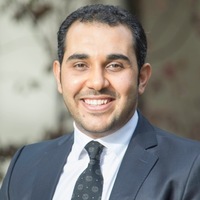- noneedit
- Dr. Rami El Assal is currently working as a Research Scientist at Stanford University School of Medicine, Stanford, C... moreDr. Rami El Assal is currently working as a Research Scientist at Stanford University School of Medicine, Stanford, CA. In June 2016, he completed his Postdoctoral Research Fellowship at the Canary Center at Stanford for Cancer Early Detection, Stanford University School of Medicine. Prior to Stanford, he completed a Postdoctoral Research Fellowship at the Harvard-MIT Health Science and Technology, Harvard Medical School, Boston, MA. Dr. El Assal received his Doctor of Dental Surgery (D.D.S.) degree from Ajman University, Ajman, UAE. Following his clinical internship, he enrolled in an Advanced Training Program in General Dentistry for two years. His clinical training was affiliated by the Royal College of Surgeons in Ireland (RCSI). Recently, Dr. El Assal completed a Certificate Program in Innovation and Entrepreneurship at the Stanford Graduate School of Business, Stanford, CA.Dr. El Assal research interests revolve around the applications of nano-/micro-technology and bio-inspired materials in medicine and dentistry. He has authored/co-authored 40 peer-reviewed articles, abstracts, and conference proceedings as well as 1 pending patent. He published his research work in high impact peer-reviewed journals, including Advanced Materials (Impact Factor (IF): 19.79), Materials Today (IF: 21.69), and Scientific Reports from Nature Publishing Group. His work has been highlighted in several news such as Reuters News, Yahoo-finance, Miami Herald, AZoNano. Dr. El Assal research achievements have been recognized by the Center of Nanoscale Systems (CNS) at Harvard University. In 2015, he was elected as a Fellow of the Academy of Dentistry International and the International Academy of Dental-Facial Esthetics.edit
Research Interests:
Research Interests:
The ability to cryopreserve human oocytes has significant potential for fertility preservation. Current cryopreservation methods still suffer from the use of conventional cryoprotectants, such as dimethyl sulfoxide (DMSO), causing loss of... more
The ability to cryopreserve human oocytes has significant potential for fertility preservation. Current cryopreservation methods still suffer from the use of conventional cryoprotectants, such as dimethyl sulfoxide (DMSO), causing loss of viability and function. Such injuries result from the toxicity and high concentration of cryoprotectants as well as mechanical damage of cells due to ice crystal formation during the cooling and rewarming processes. Here, we report preservation of human oocytes following vitrification using an innovative bio-inspired cryoprotectant integrated with a minimum volume vitrification approach. The results demonstrate that the recovered human oocytes maintained viability following vitrification and rewarming. Moreover, when this approach was used to vitrify mouse oocytes, the recovered oocytes preserved their viability and function following vitrification and rewarming. This bio-inspired approach substitutes DMSO, a well-known toxic cryoprotectant, with e...
Research Interests:
Over the past decade, bioprinting has emerged as a promising patterning strategy to organize cells and extracellular components both in two and three dimensions (2D and 3D) to engineer functional tissue mimicking constructs. So far,... more
Over the past decade, bioprinting has emerged as a promising patterning strategy to organize cells and extracellular components both in two and three dimensions (2D and 3D) to engineer functional tissue mimicking constructs. So far, tissue printing has neither been used for 3D patterning of mesenchymal stem cells (MSCs) in multiphase growth factor embedded 3D hydrogels nor been investigated phenotypically in terms of simultaneous differentiation into different cell types within the same micropatterned 3D tissue constructs. Accordingly, we demonstrated a biochemical gradient by bioprinting nanoliter droplets encapsulating human MSCs, bone morphogenetic protein 2 (BMP-2), and transforming growth factor β1 (TGF- β1), engineering an anisotropic biomimetic fibrocartilage microenvironment. Assessment of the model tissue construct displayed multiphasic anisotropy of the incorporated biochemical factors after patterning. Quantitative real time polymerase chain reaction (qRT-PCR) results suggested genomic expression patterns leading to simultaneous differentiation of MSC populations into osteogenic and chondrogenic phenotype within the multiphasic construct, evidenced by upregulation of osteogenesis and condrogenesis related genes during in vitro culture. Comprehensive phenotypic network and pathway analysis results, which were based on genomic expression data, indicated activation of differentiation related mechanisms, via signaling pathways, including TGF, BMP, and vascular endothelial growth factor.
